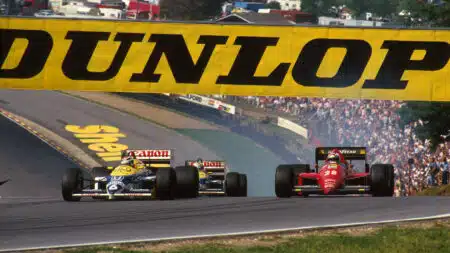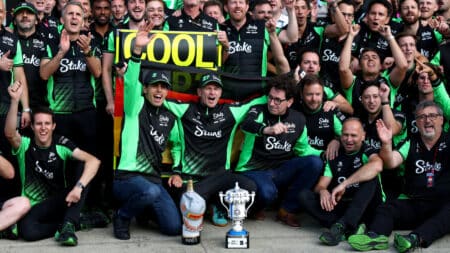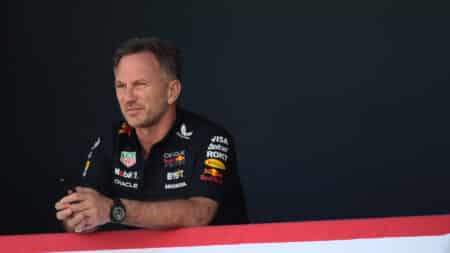
Brands Hatch: F1's beloved countryside amphitheatre
On this day in 1964, the roar of F1 engines echoed through the Kent countryside for the first time, as Brands Hatch made its debut on the world stage
Six years distant already? It seems barely feasible.
At the time Lewis Hamilton was a bright-eyed neophyte, bereft of cynicism – a 22-year-old who bounced his way through Grand Prix weekends and relished every moment of the opportunity he’d been given.
There had, naturally, been a sea of hype since his Formula 1 debut in Australia. He’d done a fine job in his first two races, but at that stage was slightly shy of team-mate Fernando Alonso’s pace: fair enough, he was a rookie taking on a double world champion. The following few weeks would be infused with a sense of equilibrium, however, and you began to wonder whether Hamilton could take the F1 title at the first time of asking. By the time we reached Canada he had still to win, but had finished on the podium in all five Grands Prix and shared the world championship lead with Alonso. It was simply a matter of when that breakthrough success would materialise: from a position of pure self-interest, most writers had hoped it would happen before we reached North America, because newspapers would be screaming for reams of supplementary copy and the time difference made deadlines tight at the best of times.
Thanks, Lewis.
This was not a straightforward race, but Hamilton made it look so. Having annexed his first F1 pole, he took the lead at the start – and Alonso’s attempt to wrest it from him caused the Spaniard to slither across the grass at the opening turn.
Hamilton was 7.7sec clear within 10 laps and remained in control through the first round of scheduled stops, but the safety car intervened shortly after he’d rejoined, Adrian Sutil having creamed the wall and left his Spyker by the track’s edge.
The race resumed on lap 27, with Hamilton leading from Nick Heidfeld’s BMW and Alonso, but would be neutralised almost immediately. Robert Kubica somersaulted into retirement after clipping Jarno Trulli’s Toyota on the run to the hairpin. The Pole sustained only a shaking and a bruised right ankle, but would be forced to miss the following weekend’s race at Indianapolis (thereby giving Sebastian Vettel an opportunity to make his first GP start).
After a seven-lap interlude the field was released again, Hamilton immediately pulling more than three seconds clear. He continued to rebuild the kind of lead of which he’d earlier been stripped and remained well clear when he made his second and final stop on lap 48. Backmarker Christijan Albers came in at the same time, having run wide and knocked off his Spyker’s nose section. Two laps later, the safety car appeared again to permit its removal from the circuit.
Hamilton made another flying restart, pulling 2.2sec clear of Heidfeld within the lap, but Tonio Liuzzi then dropped his Toro Rosso at the final chicane and a fourth safety car period followed.
The field was released for the final time on lap 61 and Hamilton strolled through the final nine laps. He took his first F1 win by more than four seconds and opened an eight-point world championship lead (something he’d extend by winning in America seven days hence). Mobile phones began going mad with requests for extra words and it would be almost 3am by the time I left the press room.
On a day of concentrated chaos, Hamilton never allowed the assorted distractions to deflect his focus. “Each time your tyres get cold,” he said, “your brakes get cold and it would be very easy to put the car in the wall. That was the real challenge – warming your tyres enough and not making any mistakes. Towards the end I was counting down the laps, getting slower and slower and thinking, ‘Right, stay off the kerbs’.”
As, indeed, he did.
He had been millimetre perfect on a day when most rivals were anything but. There was no celebrity baggage back then, though, merely brilliance.

On this day in 1964, the roar of F1 engines echoed through the Kent countryside for the first time, as Brands Hatch made its debut on the world stage

Nico Hülkenberg's long-awaited first podium at Silverstone came after a virtuoso drive, but it only came about thanks to one unforgettable qualifying lap in 2020, as Mark Hughes recalls

Nico Hülkenberg's first F1 podium followed a faultless British GP drive where he went against his team with strategy calls that proved crucial in wet weather at Silverstone. Here are the radio messages that show how he pulled it off

From shock Zoom calls to ruthless midnight firings, F1’s history is littered with team principals and executives who are in command one moment and unceremoniously sacked the next